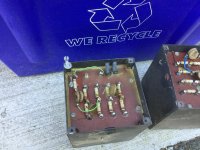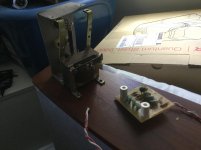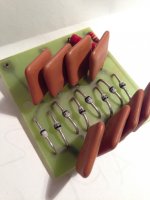I picked up another pair of 57s that need a little tlc. I have two questions
1) There used to be some information online from onethingaudio about the input transformers and ways you can check the capacitors and resistors by checking voltages across pins. Does anyone have that information?
2) My treble panels came with no dust covers. There is no indication they ran that way or of arcing, but dust has accumulated over time inside. How can I remove any dust? Can I vacuum the panel?
1) There used to be some information online from onethingaudio about the input transformers and ways you can check the capacitors and resistors by checking voltages across pins. Does anyone have that information?
2) My treble panels came with no dust covers. There is no indication they ran that way or of arcing, but dust has accumulated over time inside. How can I remove any dust? Can I vacuum the panel?
Attachments
Last edited:
No authentic people answered, so here is my view:
1. Those components never fail, but they could be roughly off tolerance (maybe +/- 25%), it does not make any difference IMHO. I swapped the 560pF capacitors on mine for polystyrene types, but can't hear any difference.
You can desolder them and measure on an LCR meter, not in service. I wouldn't care unless a component is physically broken.
2. Are you sure it is dust, and not the conductive coating on the diaphragm? I would carefully vacuum clean them boths sides with the lowest suction, going over the entire surface. Use a vacuum cleaner that can be regulated down. Don't attach any brush, just the round plastic nozzle. Air will enter in the surrounding holes and exit at the nozzle of the vacuum cleaner, along with dust particles.
Then fit dust covers according to the many instructions found on the net.
1. Those components never fail, but they could be roughly off tolerance (maybe +/- 25%), it does not make any difference IMHO. I swapped the 560pF capacitors on mine for polystyrene types, but can't hear any difference.
You can desolder them and measure on an LCR meter, not in service. I wouldn't care unless a component is physically broken.
2. Are you sure it is dust, and not the conductive coating on the diaphragm? I would carefully vacuum clean them boths sides with the lowest suction, going over the entire surface. Use a vacuum cleaner that can be regulated down. Don't attach any brush, just the round plastic nozzle. Air will enter in the surrounding holes and exit at the nozzle of the vacuum cleaner, along with dust particles.
Then fit dust covers according to the many instructions found on the net.
Thanks for that.No authentic people answered, so here is my view:
1. Those components never fail, but they could be roughly off tolerance (maybe +/- 25%), it does not make any difference IMHO. I swapped the 560pF capacitors on mine for polystyrene types, but can't hear any difference.
You can desolder them and measure on an LCR meter, not in service. I wouldn't care unless a component is physically broken.
2. Are you sure it is dust, and not the conductive coating on the diaphragm? I would carefully vacuum clean them boths sides with the lowest suction, going over the entire surface. Use a vacuum cleaner that can be regulated down. Don't attach any brush, just the round plastic nozzle. Air will enter in the surrounding holes and exit at the nozzle of the vacuum cleaner, along with dust particles.
Then fit dust covers according to the many instructions found on the net.
I’ll leave the input transformer for now then. The speakers came with 5 eht boards and two of them look fairly new. They have a number 2277-3 ESL on them that I think is an aftermarket board.
I ended up vacuuming with a short hair brush. The dust is definitely from outside. It went quite well, removed all the visible dust at least. We’ll see though, once I get the eht wired back up and the dust covers on I’ll put some juice to them. That will be the moment of truth.
Not that I'm authentic, but here's my two cents.
It's very hard to get crud out of a treble panel, the diaphragm to stator spacing is really small, and the distance from hole to hole is large compared to the spacing, so blowing them out or vacuuming them out is tough. I never even try, but I am not afraid of drilling out the rivets and rebuilding the panels. So I never spend a lot of time trying to de-crud them.
With respect to the crossover components, my twenty years of rebuilding these speakers I rarely find that the ceramic caps have failed. They are the most reliable thing in those speakers. However the original carbon comp resistors have typically drifted up significantly. I typically replace the resistors with high voltage vishay units, and the difference can be measured. You can get very good pair matching of a set of original quads if the panels aren't warped from heat or age, and the crossovers are updated. This matching leads to better imaging. For most customers, I rebuild the input transformers as follows:
Replace all resistors
Retain ceramic caps to keep speaker "voicing"
Replace banana connectors with modern gold plated banana connectors
Add zener bridge circuit to protect the treble panels.
If your output is low, especially the bass, you most likely have rectifier module problems. Don't turn up the volume to compensate for the speaker inefficienty, you'll blow up your treble panels.
hope that helps,
Sheldon
quadesl.com
It's very hard to get crud out of a treble panel, the diaphragm to stator spacing is really small, and the distance from hole to hole is large compared to the spacing, so blowing them out or vacuuming them out is tough. I never even try, but I am not afraid of drilling out the rivets and rebuilding the panels. So I never spend a lot of time trying to de-crud them.
With respect to the crossover components, my twenty years of rebuilding these speakers I rarely find that the ceramic caps have failed. They are the most reliable thing in those speakers. However the original carbon comp resistors have typically drifted up significantly. I typically replace the resistors with high voltage vishay units, and the difference can be measured. You can get very good pair matching of a set of original quads if the panels aren't warped from heat or age, and the crossovers are updated. This matching leads to better imaging. For most customers, I rebuild the input transformers as follows:
Replace all resistors
Retain ceramic caps to keep speaker "voicing"
Replace banana connectors with modern gold plated banana connectors
Add zener bridge circuit to protect the treble panels.
If your output is low, especially the bass, you most likely have rectifier module problems. Don't turn up the volume to compensate for the speaker inefficienty, you'll blow up your treble panels.
hope that helps,
Sheldon
quadesl.com
I left them overnight initially and they still sounded quiet. New diodes and they’re instantly way louder. Now the problem is I’m getting quiet ticking and staticky sounds in one treble panel. I suspect it’s the dust I saw on the panels that I tried to vacuum out. It doesn’t seem to affect the sound which is beautiful.
Interestingly the quad ESL manual says they charge up about as fast as the Quad II amp warms up or a few minutes longer. But the conductive coating on these speakers wasn't very good and evaporates over time. I've seen quads that keep charging for more than a couple days. I take measurements every few hours and I can watch the SPL increase and increase and increase.
I generally advise people to leave them plugged in for a day, that's a good amount of time that if the speakers are in reasonable shape, they will sound great after that time. If after a day, they are still not up to charge, their time has come.
Sheldon
quadesl.com
I generally advise people to leave them plugged in for a day, that's a good amount of time that if the speakers are in reasonable shape, they will sound great after that time. If after a day, they are still not up to charge, their time has come.
Sheldon
quadesl.com
Hi Sheldon
What about the fizzing and popping. It’s gotten worse as the day went by. Now they buzz occasionally while playing and not that loud either.
How humid is it in the room? These sort of issues sometimes go away when it's less humid, but you're probably looking at a panel rebuild in the end.
It’s raining heavily right now. I unplugged them for a couple of hours and plugged them back in and it’s gone away. They sound sublime right now. Extraordinary transparency.
Nice! My Quads developed ticking noises in multiple panels the first summer after I moved from the West coast to the East coast. Air conditioning helps, but the panels were basically on their way out at that point. At this moment, I have to replace a noisy bass panel in one of my Quads before I can put them back in use. Not a big job if you have the replacement panel....
Ticks and hisses are often debris that has found it's way into the panel. Are you dust covers intact? If there are tears, tape them shut.
It's a bit of a hail mary, but you can unplug the speakers and let them discharge for a day or so and then shake and tap on the speaker in an effort to shake all the debris to the bottom of the panels. Then plug them back in. You have no hope of moving the debris if the panels are at all charged up.
If you are more adventurous, you can open up the bass panel dust covers and vacuum them out.
hope that helps,
Sheldon
quadesl.com
It's a bit of a hail mary, but you can unplug the speakers and let them discharge for a day or so and then shake and tap on the speaker in an effort to shake all the debris to the bottom of the panels. Then plug them back in. You have no hope of moving the debris if the panels are at all charged up.
If you are more adventurous, you can open up the bass panel dust covers and vacuum them out.
hope that helps,
Sheldon
quadesl.com
- Status
- This old topic is closed. If you want to reopen this topic, contact a moderator using the "Report Post" button.
- Home
- Loudspeakers
- Planars & Exotics
- Quad 57 questions


